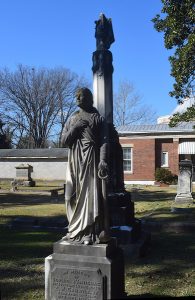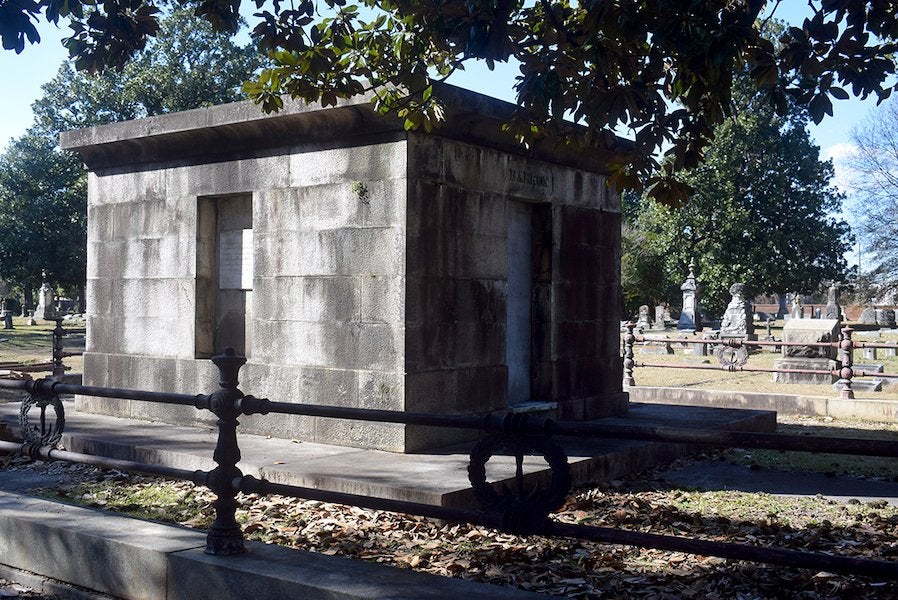Some of Augusta’s history is buried downtown.
The city’s two oldest cemeteries, Magnolia Cemetery and Cedar Grove Cemetery, are the permanent resting places for about 75,000 of the city’s earliest inhabitants.
[adrotate banner=”13″]
“So many of the city’s founding fathers are buried here,” said Jerry Murphy, administrative assistant with Augusta Recreation and Parks Department, whose office is located at Magnolia Cemetery. “I know who the (city) streets are named for. It’s like having history in your own backyard.”
The first official burial at Magnolia dates to 1818. Part of the property was once a plantation, and the Academy of Richmond County also owned part of it. The oldest marked grave belongs to J. Hartford Montgomery, who died Christmas Eve 1800.

“The first official burial was on Aug. 8, 1818, Miss Arabella Darby,” said Murphy. “In Cedar Grove, 1823 is the earliest date I’ve seen, and it’s for a child.”
The child buried at Cedar Grove was 11-month-old “Sarah Ann, the daughter of J. & E. Bouyer,” according to a printed hand-out the city has compiled.
Magnolia encompasses 65 acres and has about 34,000 people buried in it. There are five Jewish sections; a confederate section, a Greek section and a Masonic section. There’s also a pauper’s section.
There’s a section containing the graves of Isaac Tuttle and Dr. George Newton, who founded the Augusta Orphan Asylum later known as the Tuttle-Newton Home. In the section are some of the children who lived at the home.
The cemetery has some of the oldest crepe myrtles in the state.
While there are founding fathers and high-ranking military officials buried in the cemetery, there are some who don’t have streets named after them but are interesting nonetheless, he said.
One is Wylly Barron who ran a gambling room at an Augusta hotel. He was cursed by another gambler who committed suicide after losing everything he owned to Barron. The gambler said he hoped Barron would die without a grave to shelter him.
Barron wasn’t about to allow that to happen, so he revised the rules of his gambling establishment during his lifetime, donated to many charities and built a granite mausoleum 24 years before his death.
As it happened, he died at 88 without enough money for a coffin, so his body was bricked into the crypt, the keyhole was sealed over, and the key was thrown away, according to the cemetery records.
[adrotate banner=”13″]
Another person buried in Magnolia died as a result of the last duel in Augusta.
Charles Dawson Tilly was an Irish immigrant who lived in the boarding house of Mary DeLaigle. There was a rumor of a scandalous romance between the two of them. Tilly died defending her honor when he was shot by George Ratliffe in 1875.
The cemetery also boasts some unusual monuments. There’s a life-sized replica of Sophie d’Antignac who died at the age of 27. At the grave of John Martin, who died at the age of 101 and served in the Revolutionary War, there’s a cannon that he supposedly brought back from the war at the foot of his grave.
While records at Magnolia have more information about those buried there, less is known about those buried at Cedar Grove. That cemetery was designated for black residents, many of whom were enslaved.
However, many who are buried in Cedar Grove made an impact upon the city, and their legacies remain. Among them are R.A. Dent, the first black from Augusta elected to the state legislature. R.A. Dent Boulevard is named for him. A.R. Johnson, the first black in Georgia to receive a teacher’s license, is also buried there. A.R. Johnson Health Science and Engineering Magnet School is named in his honor. Prominent physician Dr. T.W. Josey, for whom the high school is named, and Judson Lyons, Georgia’s first African American lawyer, are also buried in Cedar Grove.
[adrotate banner=”24″]
Amanda Dickson Toomer was the richest black woman in the U.S. after the death of her father, David Dickson, a plantation owner. In 2000, Showtime aired a movie called “A House Divided” based on Toomer’s life. Jennifer Beals played Amanda Dickson Toomer with Sam Waterson playing David Dickson.
Charles A. Reid Sr., was the first person to be buried in a crypt at the cemetery. He was the co-founder of Blount-Reid Funeral Home. Other prominent people interred there include Dr. George Stoney, an important physician who helped set up Lamar Hospital, and the Rev. William White who founded the Augusta Baptist Institute, which became Morehouse College.
Murphy said many of the graves at Cedar Grove are unmarked, and in 2018, at the centennial observances for Magnolia and Cedar Grove, there was a ceremony to remember those unknowns.
While official records indicate 44,548 people buried in Cedar Grove, Murphy estimates that number is much too low. “We will never have a complete count,” he said.
Charmain Z. Brackett is the Features Editor for The Augusta Press. Reach her at charmain@theaugustapress.com
[adrotate banner=”37″]












